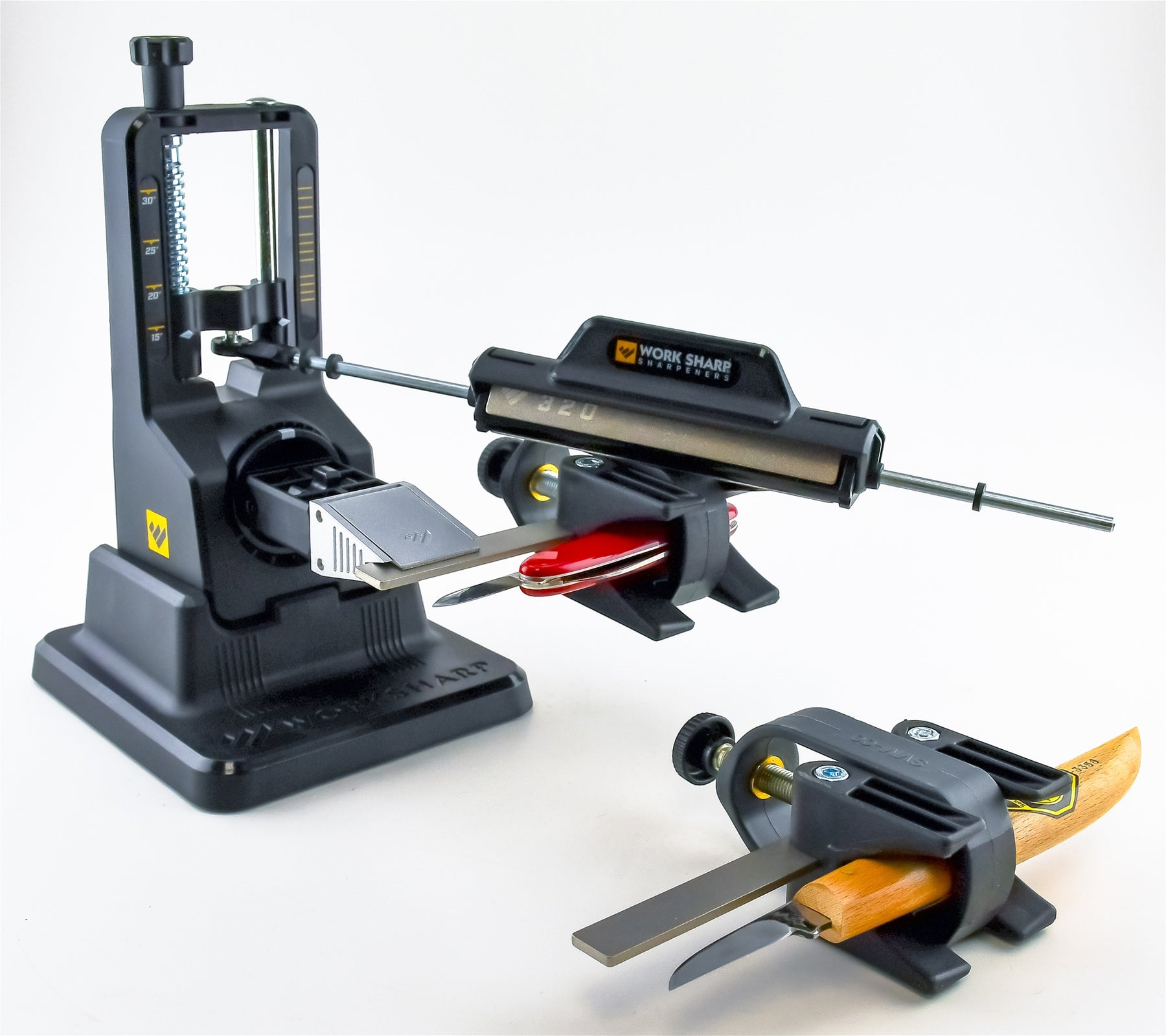Sharpening a Small Knife on a Guided Sharpener

Sharpening Small Knives on Guided Sharpeners
Small Knives and Guided Sharpeners
A customer called me recently with a conundrum. He was trying to sharpen a small knife on a guided sharpening system and was having an issue. The jaws of the clamp that holds the blade were interfering with the sharpening stone. He could not sharpen to the low angle he wanted without the sharpening stone running into the jaws.

Knives with very small blades can be difficult to clamp in guided sharpeners because the stone may come in contact with the knife clamp.
Why Small Knives are Hard to Clamp
The issue of the stone contacting the clamp when sharpening narrow blades is common among guided sharpening systems. Sharpening smaller blades to a lower angle will make this issue worse. Previously, I wrote an article, Guided Knife Sharpening System Angles by Blade Width, that illustrates the issue on three guided sharpening systems.

All types of small knives can have interference with a knife clamp on a guided sharpening system.
The problem is one of simple geometry. There needs to be a certain minimum amount of the blade in the jaws of the clamp to hold the knife securely. Likewise, there needs to be a certain minimum amount of blade projecting beyond the end of the clamp to allow the abrasive to touch the blade without contacting the jaws. With small, narrow blades, there just isn't enough blade width to accomplish both things. And the lower the sharpening angle, the more pronounced the issue becomes.
The Tormek Small Knife Jig
After talking with the customer for a few minutes, I had a thought. The Tormek SVM-00 Small Knife Jig might be of value in this situation.
The Small Knife Jig an ingenious device that holds the handle instead of the blade. Projecting from the side of the clamp is a bar that is clamped into the jaws of the Tormek knife jig. This unique configuration moves the blade about an inch beyond the end of the clamp jaws, allowing the blade to make contact with the grinding wheel on the Tormek without the jaws of the clamp interfering.
Of course, that's on a Tormek system, not a manual guided system, but why couldn't it work in this case as well? The jaws of the Tormek Knife Jig work very much the same way as do the jaws on most guided knife sharpeners. Given the similarity, this was definitely something worth investigating.
Testing the Tormek Small Knife Jig on the Work Sharp Precision Adjust
I went to our shop to test the combination to see if it would work as I hoped. I selected the popular Work Sharp Precision Adjust Knife Sharpener to test with the Tormek SVM-00 Small Knife Jig. Then I went to our knife collection to locate a couple of small bladed knives. I found a carving knife and a pocket knife with a small secondary blade.

The Work Sharp Precision Adjust has good knife clamp. However, even this clamp has difficulties sharpening this small carving knife to a low angle.
To start, I clamped the handle of the pocket knife in the Tormek Jig. I then clamped the Tormek Jig into the Work Sharp Precision Adjust. This process went very smoothly and I could tell that by moving the clamping process away from the small blade, it allowed me to adjust the sharpening angle as low as I wanted to go. I did the same with the carving knife and got the same positive result.

With the addition of the Tormek Small Knife Jig, the knife edge is moved outward and the the clamp no longer comes in contact with the hone.
One factor I realized during this test is the fact that I'm changing the geometry of the sharpener. Using my 10th-grade geometry (9th grade or earlier if you were advanced), I figured that by moving the edge of the blade outward by about 1/2", the effective sharpening angle is lowered. However, once I calculated the real-world angle, the effective sharpening angle is really quite close to the numbers provided by Work Sharp. By moving the blade outward, I simply moved the blade to where Work Sharp had expected the blade edge to be placed. In short, no math homework is required.
Testing the Tormek Small Knife Jig on the Lansky
To confirm that our method works for other systems, I decided to do the same test with the Lansky Sharpening System. This system, whether you're using the Deluxe, Professional, or Deluxe Diamond System, all use the same clamp.

With the Tormek Small Knife Jig, even this small knife can be sharpened with this Lansky System.
As before, I clamped the knife into the Tormek Small Knife Jig. I then clamped the Jig into the Lansky Knife Clamp. It worked, just as it had before. I was able to select any of the predetermined angles.
Mixing Brands of Sharpeners To Solve A Sharpening Problem

Foreground: A carving knife held in a Tormek Small Knife Jig
Background: A folding knife held in the Tormek Small Knife Jig which in turn is held in the jaws of the Work Sharp Precision Adjust.
Small knives can be difficult to sharpen on guided sharpeners that clamp the blade. This is true of all brands of guided sharpeners. There simply isn't enough blade to work with, and the clamp jaws can interfere with the sharpening stone. But we're glad to have come up with a helpful solution.
While this issue isn't new, it took a customer asking a question to encourage us to find a solution. In this case, we just needed to combine a jig from another brand to extend the usefulness of a guided sharpener. Solving this type of sharpening problem is one of the fun parts of our jobs as sharpening specialists. If you have a sharpening question, don't hesitate to ask us.


